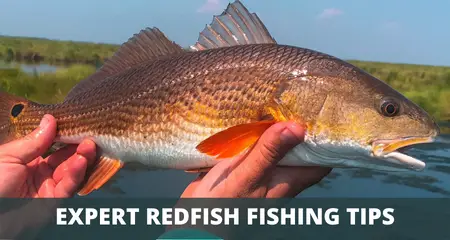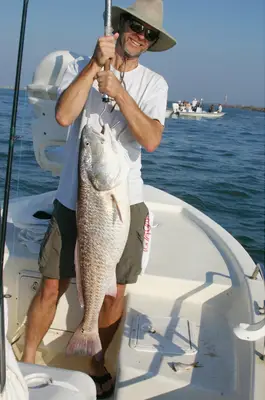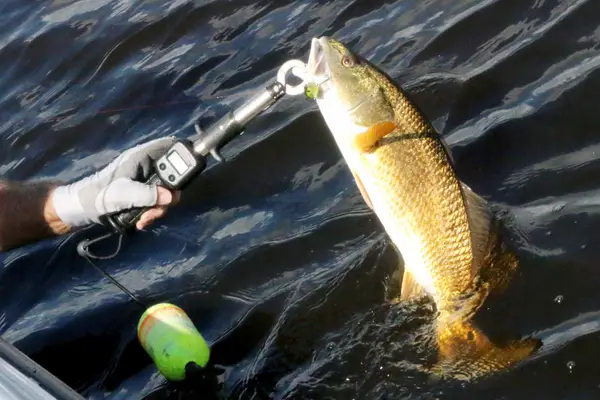Redfish Fishing Tips (9 Tricks To Catch More Fish)
UPDATED 03 NOVEMBER 2023
by Robert Ceran
When fishing for redfish, it’s not unusual to be bored for long stretches of time. Some anglers might have to wait hours, while others might have to wait days.
But persistence and patience pay off, as boredom is eventually followed by total chaos when a school of redfish moves through your area, making it likely to have multiple hookups at the same time.

In this article, we’ll show you the tools you need to become a good redfish fisherman. You’ll find that red drum are easy to get ready for, and you can catch them with a wide range of gear.
How to prepare for redfish fishing
Before you leave the dock, it’s a good idea to build your fishing rigs in advance.
When redfish start to bite, there can be anywhere from dozens to hundreds of them nearby, and you’ll need to react quickly in order to take advantage of this bonanza.
With pre-made rigs in your tackle box, you can quickly attach a new rig to your main line, and take advantage of the opportunity to catch several fish in a short time.
When and where to fish for redfish
Redfish usually come to the Chesapeake Bay in late April, or when the water temperature is between 58 and 59 degrees. Around the first week of May, catches start to happen more often.
In the Chesapeake Bay, the 9 ft shoal and the Eastern Shore near Fisherman’s Island are good places to fish early in the season.

By the third week of May, catches usually get better at the 9-foot shoal and around buoys 13 and 16 in the Bay. Also in the Inner Middle Ground and at Latimer Shoal.
As an added bonus, black drum can also be found in similar shoals and reefs on the Chesapeake Bay, especially near the edges of deeper water near buoys 13 and 16 where the water is 20 to 30 feet deep.
As the water warms up in early June, schools of redfish gather around the islands of the Chesapeake Bay Bridge Tunnel and other structures with a flat or a shoal and deeper water nearby.
I’ve seen schools of red drum that were between 60 and 100 pounds way up the Bay in Maryland, a few miles north of the Patuxent River.
What tackle to use for redfish
The most common types of fishing rods used for redfish are stand-up rods and heavy trolling rods with line classes of 20 to 50 pounds.
These are used with level-wind reels like Penn 320s or similar reels. Seeing is believing. When we caught a 48-inch and a 53-inch redfish with a medium-weight bait casting rod and a Penn 12lb class reel, it was clear that lighter tackle can be used for these huge fish.

But for the fish’s health, and because almost all of the big redfish are released, I’d recommend using heavier tackle.
Finally, if you want to cast your bait away from the boat and up on shallow channel edges, you should use a spinning rod.
How to rig for redfish
Fish finder rigs are the most important rigs for redfish fishing. These rigs have a slip sinker on top of a 60- to 80-pound heavy leader.
The fish finder rig for redfish can be set up in two ways:
First, by putting an egg sinker on the main line from the reel and holding it in place with a snap swivel. The heavy leader should be connected to the snap swivel.
In the second method, there is a slip sinker that can hold a weight and is held in place by a snap swivel. The leader is then attached to the slip sinker.
Leaders
Leaders can range in length from 2 to 3 feet. You’ll probably be throwing the bait away from the boat, so the shorter the leader, the easier it is to throw and the farther your rigs will usually go.
In general it’s easy to make your own leader, and to tie your own knots on leaders. However, if you prefer, you can also buy ready made rigs.
Weights
Most weights are between 3 and 10 ounces. The top weight I like to use is a 4-ounce egg sinker that the main line goes through.
My second go-to choice is a 6-ounce bank sinker that is connected to a slider rig by a plastic sleeve that the main line goes through.
Finally, some fishermen like to use pyramid weights because they keep the bottom in place better in strong currents.
Hooks
Hooks for redfish can be regular J-shaped hooks, Octopus hooks, or circle hooks.
Most people want at least a size 8/0 hook, and some are even going up to size 12/0 hooks. Red or black drum will take these hooks (and even bigger ones) with ease.
My favorite hooks are 8/0 Eagle Claw lazer-sharp octopus hooks.
The best bait to use for redfish
I’ve found that the best bait to use for redfish is either a half or a whole blue crab. Below are the steps for how to prepare a blue crab and put it on your hook:
- Take the crab’s top shell off and throw it into the water where you’ll put your baits. This could help to attract fish to your area.
- Next, cut the crab in half. You can use a knife or kitchen shears to do this. The latter works well when the water is rough on the shoals.
- Put the hook through the crab’s bottom shell and into the joint of its back fin. This will make sure that the bait stays in place while casting.
- Some anglers use the crab like that, but others use a rubber band to keep the crab legs in place on the leader. Either way works fine. But keep in mind that when you use a rubber band, the bait might not be able to spin if the current is moving very quickly.
If you can’t get blue crab, then peeler crabs and sea clams are also good baits. Redfish will also eat hard crabs and chowder clams, but they don’t do it as often.
Sometimes, redfish will also bite on artificial baits, especially bucktails.
Final remarks
So, now you know. Catching huge bull redfish in the Chesapeake Bay isn’t that hard.
Use a fish finder rig with strong line and strong gear, bait it with a crab or clam, and hold on.
With their huge size and strength, these fish are fun to catch and will give you memories for the rest of your life.
But please take care of these fish by handling them carefully after catching them, and respecting your local redfish limits.
Remember: the next redfish you catch could be more than 80 years old.
I hope you do well, but don’t catch them all!
